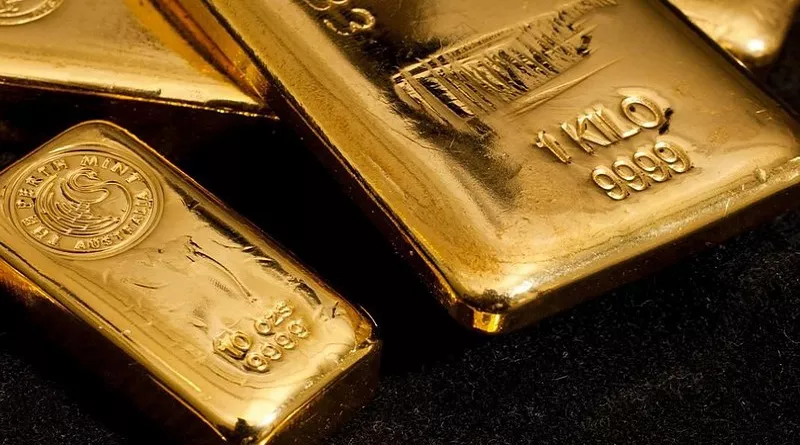In a remarkable turn of events, gold prices have soared to new heights, reaching a peak not witnessed in the past two weeks. This unexpected surge comes as U.S. business activity data presents a sobering picture, igniting speculation that the Federal Reserve might be constrained in its ability to further hike interest rates.
This surge marks the fifth consecutive session of price increases, a robust recovery from the slump seen earlier in August when the precious metal hit a five-month low. Both the dollar and Treasury yields have retreated from their recent peaks, creating a conducive environment for gold’s resurgence. Notably, spot gold has confidently reclaimed the crucial level of $1,900 per ounce, further fueling optimism among investors.
However, even as the market celebrates these gains, a sense of caution prevails in anticipation of the forthcoming Jackson Hole Symposium. This much-anticipated event, commencing later in the day, is poised to provide more insights into the trajectory of U.S. monetary policy, a factor that could sway the market sentiment significantly.
At the moment, spot gold has experienced a 0.3% uptick, reaching $1,920.67 per ounce. Meanwhile, gold futures, set to expire in December, have inched up by 0.1%, settling at $1,948.75 per ounce as of 00:07 ET (04:07 GMT).
Dollar Retreats and Treasury Yields Decline Amid Disappointing PMI Data and Jackson Hole Expectations
The dollar has taken a sharp nosedive from its two-month high during overnight trading, mirroring a similar trend in Treasury yields that have slid down from their multi-decade peaks. These movements come in the wake of the latest purchasing managers’ index (PMI) data, which has unveiled a distressing reality: U.S. business activity has witnessed feeble growth in the month of August.
This revelation has prompted speculation that the deteriorating economic conditions in the United States might severely limit the Federal Reserve’s maneuvering room to continue raising interest rates. Such a scenario, though met with caution, could potentially offer some respite to metal markets, including the gold sector.
However, despite these dynamics, the consensus remains that U.S. interest rates are poised to remain elevated for an extended period. This projection poses a potential challenge for gold, as higher interest rates amplify the opportunity cost associated with investing in bullion. This conundrum has taken a toll on gold’s performance over the past year and is expected to temper any significant surges in the precious metal’s value.
The focal point of market attention has now shifted towards an impending address by Federal Reserve Chair Jerome Powell at the Jackson Hole Symposium, scheduled for Friday. Analysts sound a note of caution, suggesting that the persistence of sticky inflation and a robust labor market might still pave the way for a hawkish outlook from Powell. Such a stance from the Fed Chair could reignite discussions about future rate hikes and the broader economic implications.
Copper Benefits from Dollar’s Softening, Yet Soft PMI Figures Weigh In
In contrast to the upward trajectory of gold, copper prices have experienced a minor dip on Thursday. Futures for the red metal have contracted by 0.2%, settling at $3.8040 per pound.
In recent sessions, copper prices had witnessed a robust rally, drawing strength from a weakened dollar and expectations of further stimulus measures from China. However, this upward momentum has encountered a roadblock in the form of lackluster PMI readings from both the U.S. and the euro zone. These readings have unveiled a concerning reality: manufacturing activity in the world’s largest economies is experiencing a slowdown, a trend exacerbated by the backdrop of elevated interest rates.
The focus has now turned decisively towards China’s upcoming PMI readings, set to be unveiled next week. These figures are poised to serve as a litmus test, offering insights into the economic health of the globe’s largest copper importer. The outcomes of these readings will undoubtedly influence the course of copper prices in the coming weeks, as market participants grapple with the broader implications of the ongoing economic dynamics.
In conclusion, the prevailing market dynamics are characterized by nuanced interactions between economic data, policy decisions, and investor sentiment. The surge in gold prices, a standout feature in recent days, reflects a market grappling with uncertainty amidst a backdrop of shifting economic indicators. The dollar’s retreat and Treasury yields’ decline serve as stark reminders of the fragility of economic growth, amplified by disappointing PMI figures. As investors eagerly await Powell’s address at the Jackson Hole Symposium and China’s upcoming PMI readings, the only certainty is the ongoing interplay between economic resilience and vulnerability on the global stage.

